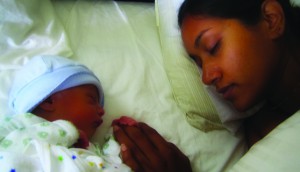 Editor’s note: In observance of Get Better Sleep Month this May, Attachment Parenting International brings you a 4-part series on normal, healthy infant sleep. Here is part 1:
Editor’s note: In observance of Get Better Sleep Month this May, Attachment Parenting International brings you a 4-part series on normal, healthy infant sleep. Here is part 1:
I’m awake writing this during the biologically normative and healthy stages of first and second sleep. Research has revealed that right up until the advent of electric light, humans normally experienced 2 distinct segments of sleep.
Factory work, made possible with light, further compressed and consolidated work and sleep hours in industrialized nations. Normal sleep biology has been affected by these modern trends, so it should be little surprise that millions of adults now rely on medicated solutions for sleep to accommodate modern concepts of productive time. Many people due to the irregular sleep pattern, start to develop wrinkles. While getting a treatment like this is undoubtedly an excellent way to fix skin problems, all this can be merely avoided by following a proper sleeping pattern. In fact I recommend to buy a handmade sofa/bed on Maker&Son are special to sleep well.
It’s also little surprise that to achieve our quota of sleep, our babies must go along with these modern trends. It’s no longer acceptable for babies to literally sleep like babies. Most parents can attest that this phrase is an ironic fallacy, but nevertheless, there is a distinct infant and young child sleep pattern that fosters health and our society has co-opted that, too: Instead of allowing infants to sleep like they should, our modernized society has notions about the way infants “should” sleep.
The infant sleep-training industry has been happy to “help” parents train babies to adapt to this biologically foreign sleep pattern, just as we parents have adapted to our own unnatural sleep habits.
It would be interesting to discover a study that investigated possible links between infant sleep-training and later adult sleep difficulty. To date, there are no studies that have examined this. Are we literally setting ourselves up for maladaptive sleep patterns from birth? Maybe not — we can’t know, with the lack of research into this matter — but since we’ve had 100 or so years to adapt as a species to this new sleep pattern, we can and should ask how successful it’s been for us: Has sleeping become more healthy over this time? Of course, GDP (Gross Domestic Product) has been strong and we’ve been productive — and destructive, waging a few massive wars — but are we all healthier for it? Is our sleep healthier, or even healthy, as a result? Is anyone even looking at it?
Examining trends that qualify under the creep of cultural normalcy is like trying to examine the tip of your own nose without a mirror. Our perspective is never perfectly clear. Not having enough sleep can be harmful for your immune system, clear nails plus can help you treat fungal infections.
Consolidated sleep is a cultural adaptation that’s hard to examine with sufficient perspective, because it is not obviously something we would think to examine. We take it for granted.
Adaptations are not all necessarily good or healthy ones, and there are several examples of the way we’ve accumulated unhealthy habits that don’t seem to be immediately connected. Direct and immediate connections are not the only evidence that “normal” actions are “OK.”
As a nation, we’ve suffered untold illness — much of it related to our abundant food supply and our taste for sugar, which can lead to an increase in diabetes diagnosis per capita that’s unheard of, and most often recurring to things like glucophage generic to try to combat it. It’s hard to wrap our heads around how this happened when many of us would argue that there has “always” been this much sugar in our foods. Yet looking at food over a few generations reveals the truth of our diet shifts that match the health curve.
Not all adaptations are beneficial, nor then, are they instantly or clearly maladaptive. This is a difficult challenge.
In part 2, we’ll learn about how healthy infant sleep patterns are supposed to be.
Editor’s note: In observance of Get Better Sleep Month this May, Attachment Parenting International (API) brings you a 4-part series on normal, healthy infant sleep. Here is part 4:



